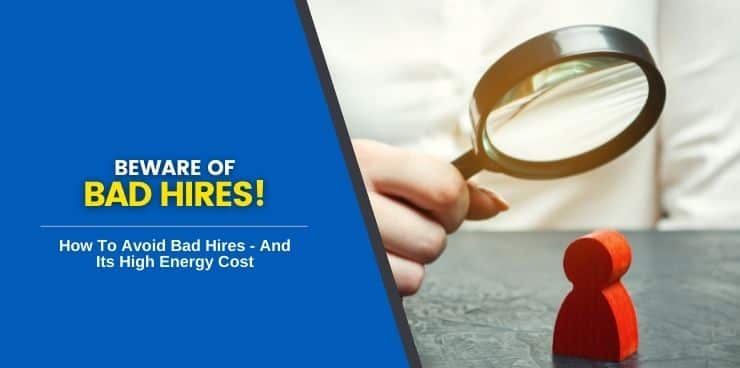
Did you know that the average cost of bad hires is $18,000?
That amount is almost ⅓ of what a typical residential home service Technicians earns. Sadly, bad hires are incredibly common in today’s business climate. According to a CareerBuilder survey, 2 in 3 newly hired people later realized they were a poor fit. Half of them quit in a span of 6 months, which means employers are left to face the same predicament:
Recruit. Hire. Train. Quit. Repeat.
A staggering 74 percent of employers say they’ve made a poor hiring decision. These people know how the cost of recruiting a new employee sting. They can impact businesses in more ways than you can imagine— monetarily and non-monetarily. This fact is more painful for residential home services with a tight labor market and requires a defined skillset.
How then can you avoid bad hires and their costly repercussions? We’ll answer that here. Keep reading.
What Do “Bad Hires” Mean?
Imagine your team hired a new Technician. Promising, skilled, and personable. They were exactly what your company thought it needed. But after the first month at work, it was clear that something was wrong. The new hire is no longer the promising candidate you knew during the application, interview, and screening process.
You think to yourself: he or she simply needs a bit more time to acclimate and adopt the culture. Despite your reasoning, the warning signs of a bad hire are evident.
Recruiters, employers, and hiring managers all dread the same scenario post-hiring decision. Sadly, this is all too common in businesses that provide residential services like HVAC, plumbing, or garage door repair.
Hiring the wrong employee has become an epidemic but who exactly are these people?
Understanding the meaning of bad hires reduces your risk of making them. Knowing who they are will reveal to employers the biggest red flags to watch out for when hiring.
Some might say they’re the ones that show up late, have bad attitudes, bad work habits, and lack motivation. Others would argue they’re people who constantly call in sick, require frequent supervision, and perform poorly.
These are tell-tale signs, but they’re not necessarily the definition of bad hires. A bad hire is either one or both of these two things:
- The aptitude isn’t matched to the company’s performance standard.
- The attitude isn’t fitting to the company’s culture.
A newly hired employee should possess the aptitude to perform competitively in step with your business’ standards. In the same manner, they should have the attitude to harmonize with team members and live out your company’s vision. There’s no one or the other.
A bad hire can spell disaster for your business if it slips under your radar.
Bad Hires Cost Precious Energy
Hiring a new employee takes a lot of energy which often comes in the form of time and money. The longer it takes to fill a new position, the more resources are used up. This also means other people are left to pick up the vacancy’s slack.
All of these elements hurt your budget and your team’s morale. While the cost of hiring an employee is already high, hiring the wrong employee adds even further insult to injury. Bad hires can cost you double the amount and effort spent on recruiting them in the first place.
You don’t want that.

Why Do Companies Make Bad Hires?
If bad hires are that bad, it now begs the question: why does it keep happening?
We’ve bought into a 200 year old bill of goods that skills matter more than culture. This myopic hyperfocus on achievement, experience, and skillsets are the culprit behind every company’s anemic culture.
Ironic, isn’t it?
Our aggressive attention to workplace viability causes hiring managers to overlook cultural fitness. This element matters so much in 2022, and I’ll explain why in a bit.
This year, HVAC and other residential home services suffer from the Great Resignation. That means more Baby Boomers are turning 60, leaving the industry for good. Now, companies are left gasping for air to deal with their departure. There are some jobs that hire on the spot, while others have increased their hiring rate. The bottom line is that this creates a big problem with hiring bad hires.
When you pair this with ever tightening immigration regulation and a lower than needed birth rate, the United States along is short 11.1 million people to fill the current vacancies for work. This means that 11.1 million jobs have to remain unfilled as there are not enough humans to fill the position. 11.1 million.
So you’re not just competing with your competitors who are desperate to fill their roles. You are competing with every other career opportunity where they can make more money in less time, doing something more pleasant than sweating profusely in a 110 degree attic.
Unless you know the warning signs of a bad hire before it even happens, you will almost certainly suffer the same fate. Below I’ll walk you through how to prevent it.
How Can We Avoid Bad Hires?
Avoiding bad hires is a proactive approach. It doesn’t begin during the screening process, it start with the right recruitment ad. When you job ad focuses on the things that actually matter, you reduce the chance of having the wrong people apply to your company. Appealing to the right people means you will end up with fewer bad hires.
For example, millennials value culture more than money. This survey says they’re willing to take a pay cut to work for a company that shares their values. What does this tell you?
In this business climate, what makes a difference between good and bad hires is culture. If your company’s culture, values, and principles don’t speak the applicant’s language, you will notice in their performance and actions. Similarly, if a candidate doesn’t see eye to eye with your culture, they won’t fit in and it will show.
Establishing culture before the interview, before the screening, heck, even before the recruitment ad, is key to preventing bad hires.
Does that mean skillsets matter less?
Of course not. The problem arises when we myopically focus on tangible skills and achievements without giving culture the same level of importance.
Here are three actionable ways to avoid bad hires:
 1. Attract the Right People
1. Attract the Right People
Attracting the right people goes both ways. You want to entice the right cultural fit, and candidates are also searching for the best employers.
If you want the right people to apply, they have to know you exist first. Millennials and Gen Zs now flood the workplace scene so you need to speak their language. Establish your online presence, build a community, highlight your advocacies, and position yourself as the best company in your industry. This is particularly effective for home services on Facebook, Instagram, and TikTok, but don’t underestimate the power of a mass media campaign to get more people paying attention to you.
You can also establish your culture and attract the right people using your recruitment ad. Say, if your culture promotes open communication and constructive criticism, you can demonstrate that through the ad. You want to use the right language in your ad. It should speak to your target audience and reflect your brand identity.
Your ad should tell candidates what they can expect from working with you.
For example, if you’re looking for new Technician, don’t just say “We’re hiring skilled Techs.”
Try something like this instead: “Your friends call you when they need help moving their couch because they know you’ll show up every time. When you see someone on the side of the road, broken down, you stop and offer a hand. You’re curious about all kinds of funny little things and always poke around to find out how things tick.”
This type of ad is more likely to attract people who are in line with the position you need filled and aligned with your values and beliefs.
2. Hire Slow, Fire Fast
Assuming you have a clear understanding of what you stand for and what you stand against, and are willing to stand up for what you believe to be right, you can find people who believe what you believe in. Like any lasting relationship, take things a bit slower before jumping into a long term relationship.
Know each other. Decide whether you like each other. Be interested in the candidate. Show them that you take this seriously. Be picky. Don’t settle.
One of the most effective ways to do this is with a tool we use with all of our Clients. The right psychometric tools will help you identify how a person will perform in their job AND with your culture. Not all psychometric tools are legal or helpful, so be sure to look into what tools are best suited to finding the right fit before you invest your money, energy, and time into a new candidate. This will dramatically reduce your likelihood of bad hires.
3. Indoctrinate and Initiate
Once you’ve agreed to hire a new candidate, you have the opportunity mold them into the superstar you’ve always envisioned. Left unattended, you are likely to get exactly what you invested into them — disappointment.
Don’t blame the new employee though. The responsibility lies solely on your shoulders. If you don’t train them, motivate them, compensate them, and help them succeed, the only failure is you. And half-assing your onboarding only counts in horseshoes and hand grenades.
You need to have an obsession for onboarding. This is the honeymoon period and it’s essential that you set the stage for what is tolerated, valued, measured, and meaningful in your business. You need to be explicit in your instructions on how to do things in your desired way. Be sure to pace the learning out over a period of time that allows for long term retention and understanding. Saying something once so that you can claim you said it is not training.
The human mind is designed to forget. Deliver you message at the necessary frequency and impact if you ever hope to make your lessons sticky. That means following a very specific frequency for your training and development programs.
 How Do Bad Hires Burn Your Energy?
How Do Bad Hires Burn Your Energy?
Failing to make your culture the strategy exposes your business to bad hires. This results in a lot of wasted money. With inflation in the US, this is something you can’t afford. However, there’s more that businesses lose during attrition than what you see on a P&L. There are “energy” costs that affect your business as well.
They come in four forms:
-
Lost Capacity
According to HireVue, it takes 42 days on average to fill a vacant position. The longer the position takes to get filled, the less earning power the company has. While current employees can cover the responsibilities left by the vacated position for a while, pushing them relentlessly will only lead to burnout.
-
Lost Time (Recruiting and Training Bad Hires)
The processes of writing, posting, and promoting the recruitment ad take time. In addition, sifting through applications, screening promising applicants, holding multiple interviews, and checking references all do too. The worst waste of precious time is onboarding new employees only for them to walk out the door because of bad fit with the company, the bosses, the job, or the team.
-
Low Morale
When employees are demoralized, they start doing the bare minimum. They are lethargic and apathetic. They don’t like their work. They do not identify with what the company stands for any longer. They question if this is feeding their purpose in life. They seek a new, interesting, and different challenge. Low morale only leads to poor performance, less urgency, and lost productivity.
-
Lost Productivity
Liebig’s Law of the Minimum states that productivity is not controlled by the total resources, but by the scarcest resource. Bad hires drain profitability with low productivity. They siphon hours, consume more resources, and deliver lackluster results. This has an indirect, but very relevant negative impact on your bottom line, putting your business in a bad financial position. Nipping them in the bud before they step foot in your company is the best strategy.
All four of these draw on your two most measurable resources, time and money. Worse though, is that this affects your energy as a business owner. It causes you stress, frustration, anxiety, and depression. It eats away at you, and in turn, your negative disposition could be felt throughout the business.
As the leader, avoiding bad hires by ferociously protecting and defending your happy, healthy, wealthy culture is job one, for it is your culture that determines your success.
How?
When you have a happy, healthy, wealthy culture, you have employees ready willing and able to do what you need to grow the business profitability, which only attracts more talented people to your organization to accommodate profitable growth. It’s a self-fulfilling prophecy. But it takes a special kind of commitment to communication and intention.
When new hires are a cultural fit, you’ll notice a positive increase in your employee retention rate, and that not only saves you $18,000 a head, it makes you many millions of dollars in revenue.
It begins and ends with culture. If you want to eliminate the bad hires, it’s time to revamp your recruitment tactics. Wizard of Sales® can help you rake in the best people for your culture. Book a call.
- Futuristic Game for the Ad Masters - July 11, 2024
- Classical Conditioning: Pavlov’s Dog in Advertising - June 20, 2024
- Hear, See, Speak No Advertising - June 9, 2024
